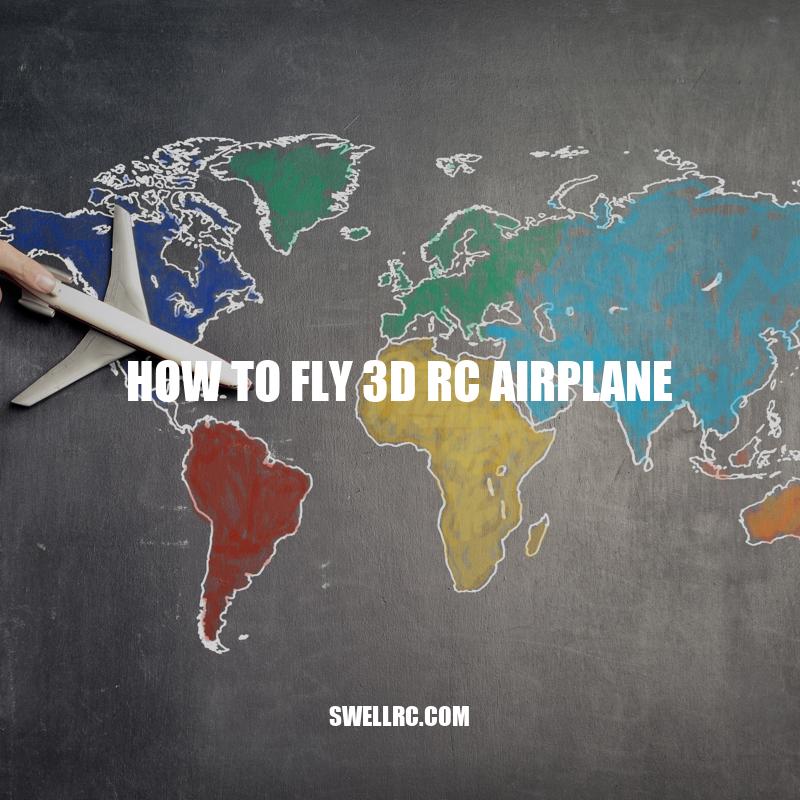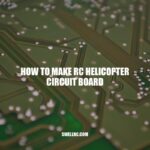Beginner’s Guide to 3D RC Airplane Flying
Flying a 3D RC airplane can be an exhilarating experience, but it requires a certain level of skill and practice to master. If you’re new to flying 3D RC airplanes, it’s important to start with the basics and work your way up to more advanced maneuvers. The first step in learning how to fly 3D RC airplanes is to choose the right plane for your skill level. There are different types of 3D RC planes available, including sport and scale planes, indoor and outdoor planes, and electric and gas-powered planes. Each type of plane has its own unique features and characteristics that make it suitable for a specific level of experience. It’s important to choose a plane that matches your skill level and experience to ensure a safe and enjoyable flying experience. Once you have the right plane, you need to learn how to handle it correctly to perform basic maneuvers such as bank turns, loops, and rolls. With time and practice, you can progress to more advanced maneuvers and become a skilled 3D RC airplane pilot.
Choosing the right plane
When choosing a 3D RC airplane, there are several factors to consider. Here are some tips to help you make the right choice:
- Determine your skill level: Are you a beginner or an advanced pilot? Choose a plane that matches your experience level.
- Consider the plane’s wingspan: A shorter wingspan is better for beginners, while a longer wingspan offers more stability for advanced pilots.
- Choose an electric-powered plane if possible: Electric planes are easier to handle than gas-powered planes and require less maintenance.
- Consider the flight time: Choose a plane with a flight time that matches your needs. Beginner planes usually have shorter flight times than advanced planes.
There are many websites and online stores where you can find 3D RC airplanes. Some popular websites include HobbyKing, Tower Hobbies, and Horizon Hobby. These sites offer a wide range of planes for all skill levels, as well as accessories and replacement parts. It’s important to read reviews and compare prices before making a purchase to ensure that you get the best value for your money. Additionally, you can join online forums or groups dedicated to 3D RC flying to connect with other pilots and learn from their experiences.
Are There Any Electric Powered Airplanes?
Yes, there are electric powered airplanes available in the market. Here are some examples:
- The Pipistrel Alpha Electro is a two-seater electric airplane that has a range of up to 75 minutes.
- The Airbus E-Fan is an all-electric experimental aircraft that has a range of up to 46 miles.
- The Solar Impulse 2 is a solar-powered airplane that completed a round-the-world flight in 2016.
These electric airplanes are not yet commonly used for commercial flights, but they show potential for the future of aviation. For more information, visit the manufacturers’ websites.
Getting started
Before flying your 3D RC airplane, it’s important to prepare yourself and your equipment. Here are some tips to help you get started:
- Check the weather conditions: Choose a sunny day with low winds to make your first flight as smooth as possible.
- Find an open field: Choose a location with plenty of open space to minimize the risk of crashes.
- Check your equipment: Ensure that your radio is working properly and that the batteries are fully charged.
- Perform a pre-flight check: Check your plane for any damage or loose parts before taking off.
Components of the radio system
| Component | Description |
|---|---|
| Transmitter | Allows you to control the plane from the ground. |
| Receiver | Receives signals from the transmitter and relays them to the plane’s electronics. |
| Servos | Control the plane’s movement by adjusting the control surfaces. |
Many websites offer detailed guidelines on how to set up and use your 3D RC airplane, such as RCGroups and RCGF. It’s important to read through the manual and follow the instructions carefully. Additionally, many RC clubs offer training programs for beginners to help them learn the basics of 3D flying. By following these tips, you can get started on your journey to becoming a skilled 3D RC airplane pilot.
Basic maneuvers
As a beginner, mastering the basic maneuvers is crucial to learning how to fly a 3D RC airplane. Here are some of the most important basic maneuvers and how to perform them:
- Roll: Tilt the wings of the plane to roll it left or right.
- Loop: Pull back on the elevator to tilt the plane upwards, then push it forward to complete the loop.
- Immelmann: Pull back on the elevator to climb, then roll the plane 180 degrees and come out of the maneuver in level flight.
- Split-S: Invert the plane and half-roll it to dive downwards, then pull out of the maneuver in level flight.
It’s important to practice these maneuvers in a safe and open area to avoid crashes. A simulator can also be a useful tool to practice these maneuvers without fear of damaging your plane.
There are various websites and YouTube channels that provide tutorials on how to fly a 3D RC airplane, such as Flite Test and RC Flight Academy. Additionally, some online stores, such as Motion RC, offer 3D RC airplanes and accessories for beginners. By practicing these maneuvers and seeking guidance from experienced pilots, you can become a skilled 3D RC flyer in no time.
What are the basic maneuvers in flying?
Here are some basic maneuvers in flying an aircraft:
- Straight and Level Flight
- Climbing and Descending
- Turning
- Stalling and Recovery
- Spin Recovery
These maneuvers are essential in learning how to fly. It’s important to master these basics before moving on to more advanced maneuvers. Visit FAA or AOPA for more information on flying basics.
Advanced maneuvers
Once you have mastered the basic maneuvers, you may want to move on to more advanced maneuvers that can help you compete in 3D RC airplane events. Here are some advanced maneuvers and tips on how to perform them:
- Torque Roll: Maintain the plane’s vertical axis while rotating it on its yaw axis. This maneuver requires a high power-to-weight ratio and a responsive throttle.
- Harpin: Perform a half-loop, followed by a half-roll, and complete the maneuver in level flight. This maneuver requires a properly trimmed plane and precise stick movements.
- Knife Edge: Maintain the plane’s lateral axis while flying perpendicular to the ground. This maneuver requires precise control of the elevator and rudder, as well as a well-balanced plane.
- Pugachev Cobra: Perform a sharp pull-up, followed by a 90-degree pitching rotation and a quick recovery. This maneuver requires a high thrust-to-weight ratio and a responsive elevator.
Again, it’s important to practice these maneuvers in a safe and controlled environment to avoid damaging your plane. Seeking advice from experienced pilots or joining a local RC airplane club can also be helpful in mastering these maneuvers.
There are a variety of resources available to help you learn advanced 3D RC airplane maneuvers, such as YouTube channels like RC Informer and websites like FlyingGiants.com. Additionally, there are online stores that specialize in 3D RC airplanes and accessories for advanced pilots, such as Chief Aircraft and Horizon Hobby. By continuing to push yourself and learn new maneuvers, you can become a skilled 3D RC airplane pilot and take your flying to the next level.
What are the 4 basic flight maneuvers?
The four basic flight maneuvers are:
- Straight and level flight
- Turns
- Climbs
- Descents
These maneuvers are essential for all pilots to master and form the foundation for more advanced flying techniques.
If you’re interested in learning more about aviation or becoming a pilot, check out websites like AOPA.org or products like the Private Pilot Flight Training Bundle from Sporty’s Pilot Shop.
Safety tips
While flying a 3D RC airplane can be a lot of fun, it’s important to prioritize safety to prevent accidents and injuries. Here are some safety tips to follow:
- Always fly in an open area away from people, buildings, and power lines.
- Check the weather conditions before flying to avoid flying in strong winds or rain.
- Always check your equipment and airplane before flying to ensure they are in good condition.
- Never fly alone. Always have someone with you to act as a spotter and to assist you in case of an emergency.
- Know your own skill level and stick to maneuvers that you are comfortable with.
- Use a frequency scanner to ensure there are no other users on your radio frequency.
- Wear eye protection to avoid damage to your eyes from debris or spinning parts.
Following these safety tips can help keep you and others safe while flying a 3D RC airplane. In addition to these tips, joining a local RC airplane club can provide opportunities to learn from experienced pilots and fly in a safe and controlled environment.
There are also several online resources available for safety information and equipment, such as the Academy of Model Aeronautics and RCGroups.com. Investing in quality safety gear, such as protective goggles and high-visibility vests, can also help keep you safe during flights. By prioritizing safety and utilizing available resources, you can enjoy your 3D RC flying hobby to the fullest while minimizing risks.
What are 10 safety precautions?
Here are ten general safety precautions to follow:
- Use protective gear such as helmets, goggles or safety gloves when necessary
- Check and follow the instructions on equipment or machinery
- Secure materials and tools when using ladders or working at heights
- Use caution when walking on slippery or uneven surfaces
- Avoid distractions such as using phones or listening to music while operating machinery or driving
- Be aware of potential hazards such as electrical cables or hot surfaces
- Follow proper lifting techniques
- Ensure sufficient lighting and ventilation in work areas
- Stay hydrated and take breaks when necessary
- Report any safety concerns to your employer or supervisor
For industry-specific safety precautions, consult the relevant manuals, guidelines or websites such as OSHA.gov.
Conclusion
Flying a 3D RC airplane is a thrilling experience that allows you to enjoy the freedom and creativity of flight. However, it takes patience, practice, and knowledge to become a skilled 3D pilot. By following the tips provided in this article, you can start on the right track to mastering this exciting hobby.
Remember to choose the right plane and equipment, prepare properly before each flight, and start with basic maneuvers before progressing to more advanced tricks. Make sure to prioritize safety at all times, and don’t hesitate to seek guidance from experienced pilots or join an RC airplane club.
With the right training and practice, you too can learn how to fly a 3D RC airplane and impress others with your skills. So, grab your remote and get ready for takeoff!



